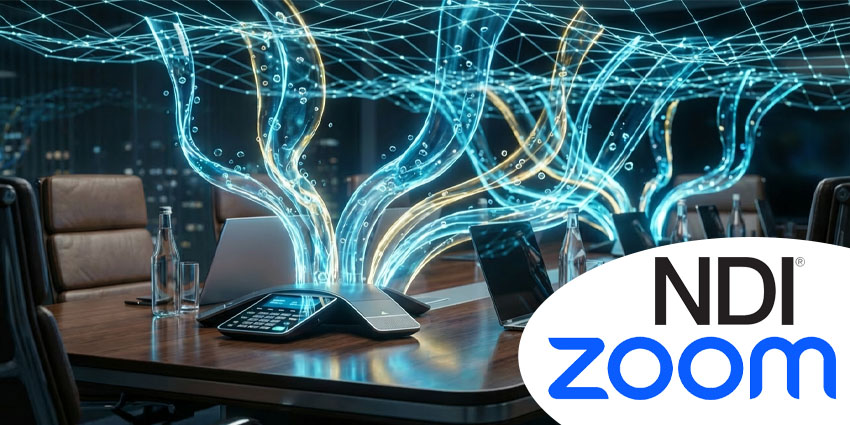It was one of the questions on the lips of many affiliated with UC&C when the Apple Vision Pro was first announced last summer — could the spatial computer revolutionise how we communicate and collaborate?
Cisco, Zoom and Microsoft certainly thought so — or at least hedged their bets — ensuring that Webex, Teams and Zoom apps were ready to go live on the Vision Pro store once the product became generally available for organisations and Joe Public (if they could afford it) at the beginning of February.
It’s still very early days for both the Vision Pro and the concept of XR and spatial computing technology being utilised for communications and collaboration, but UC Today canvassed its panel of experts on this month’s Big UC News show for their thoughts so far on the device and their predictions for its future.
“What I think is most interesting about this is the timing of the entrance of Apple into the market,” said Maribel Lopez, Principal Analyst at Lopez Research. “There have been many failed attempts at this before, and usually the biggest issues around are useability. Apple is very good at nailing the useability aspect of something. So, they’re entering at a time when Microsoft has exited from the Holo space, and there were contracts that didn’t end up happening as a result of them exiting.”
“There is opportunity in the market, and it is at the enterprise level. As consumers, we get all excited, and we’re like, ‘Well, who’s going to pay $3,500?’ But it’s not your average consumer. It’s a big business; it has a business use case.”
Lopez suggested examples of an architectural firm that designs buildings with a globally distributed workforce that is doing digital twin plan redesign. In that circumstance, that kind of collaboration use case matters.
“Things where there are millions of dollars on the line, and it makes sense to buy a few $3,500 or many $3,500 devices to do it, and you have to start there and work it down so the technology curve is cheaper,” Lopez continued. “We are getting to the point where headsets are lighter; their gesturing is so much better than what we’ve seen in the past, and the quality of the visuals is so much better.”
“So a lot of the failed promises of the last set of technology have been fixed, but you’re still faced with what do I do with it. If you’re a gamer, yeah, okay, that’s a different use case. If you’re not a gamer, you don’t really care so much about it as an individual consumer.”
“But, if I have one of those use cases where I’m facing a labour shortage, I’ve got all new people in, and there’s one person who knows how to train somebody on the ‘blah blah’ that’s 5,000 miles away, then this is a use case that works.”
Lopez doesn’t believe we’ll see Vision Pros “flying off the shelves” but argued that that’s the point.
“I think you have to start somewhere, and if they fix the usability problem, they already have a rich app ecosystem, people who like to go for them, they already have distribution mechanisms into the enterprise for how to buy and manage applications,” Lopez expanded. “It could be a win; it’s just a longer game. I think that’s the one thing that Apple is good at, they play the long game. We’ll see what happens next.”
Zeus Kerravala, Principal Analyst at ZK Research, highlighted a compelling predicatment; that the use cases Lopez suggested are those that have always been available for spatial computing, “so the Webex, Zoom, and Microsoft Teams integrations don’t really add to that”.
“I don’t see us sitting around doing this over headsets,” Kerravala added, referring to UC Today‘s panel discussion over video. “It doesn’t really add anything to it.
Craig Durr, Senior Analyst at Futurum Group, goes further than Kerravala, saying that he actually thinks it detracts from the experience because “if you’re wearing one right now, I don’t see you. What do I see, an avatar? So it’s a degraded experience for me.”
“I mean, everyone shows the visual of the meeting with Brady Bunch boxes right now, but that one person wearing the headset, how are they represented in that meeting?” Durr continued. “They don’t show that point of view in the marketing (of the Vision Pro).”
UC Today’s Rob Scott highlighted that this arguably might be the case at the start of 2024, but the Vision Pro’s first iteration might be laying the foundations for more robust, groundbreaking and universal use cases in the future. Scott suggested that his 13-year-old child will grow up with this technology as the new normal.
“Do real and general knowledge workers want to use this? is this the way for them? Is it compelling enough? I don’t think we’re there yet, but I think Rob’s point about the long game is more interesting,” Lopez said. “If people grow up with the technology, similar to how people grew up with cell phones, does that change the dynamic of what a meeting looks like?”
“I think that’s a longer-term thing, but don’t you feel like they picked up on the announcement and did the apps because they want to show that there’s forward movement in the collaboration space? Honestly, despite all the announcements, collaboration isn’t that different. My face is looking at your face. The quality of that has gotten better, and the audio quality of that has gotten better. We haven’t really disrupted what that looks like yet.”
Kerravala highlighted that Cisco is developing a hologram product that might eventually culminate in producing a similar experience as the Vision Pro but without the headset — in that sense, then, “maybe what Apple is doing as a stepping stone towards that”.
“That Star Trek Discovery experience when you’re talking to a hologram and you can interact with them without headsets is ultimately where you want to get to,” Kerravala added.
“Right now, I do agree, Maribel, with the types of use cases you gave. If I’m looking to invest in a building in Dubai or something like that and I want to walk around it — it’s a great use case for that. If I’m an auto manufacturer and I want a bunch of people in Geographic, it’s a great use case for that. But it is just really, really niche right now, especially at that price point.”
For Durr, while we’re not at the revolutionary stage quite yet, the version of spatial computing and augmented reality that will represent a sea change for collaboration will be interesting.
“Rob, to your 13-year-old, they’ll be used to seeing an overlay of information on top of everything else,” Durr said. “Even, for example, I might be presenting, I can start getting information like audience sentiment, I can get feedback about whether I am being longwinded, and things like that could help in the collaboration element of this.”
“The promise is there, but there’s a lot of sizzle, and I’m still waiting for some steak.”








